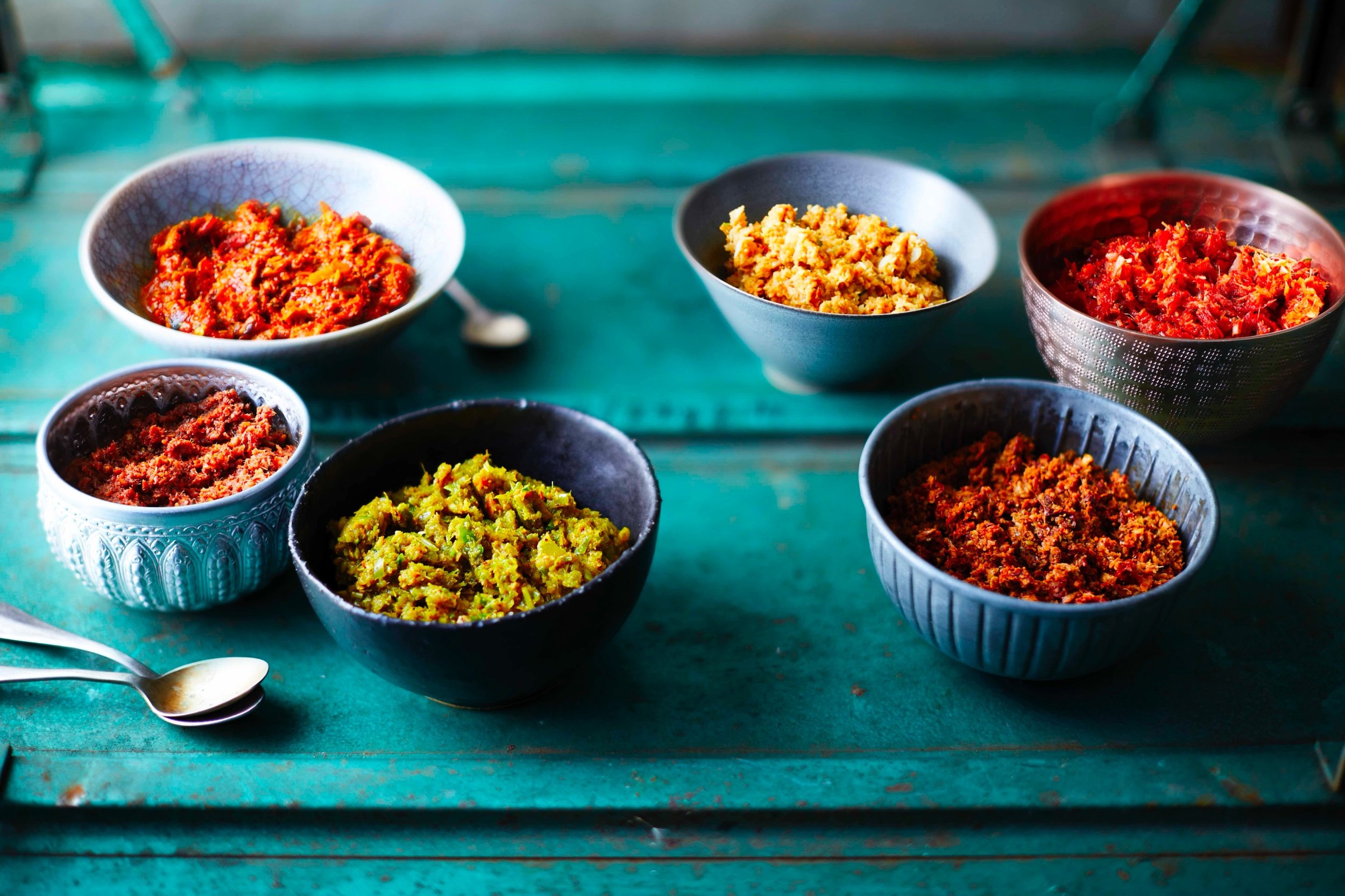Mastering Thai Curry Pastes: A Chef's Guide to Authentic Flavours

Let's talk curry pastes - the backbone of Thai cuisine and, quite honestly, the reason I fell head over heels for this incredible food culture. After years of grinding, pounding, and occasionally cursing at my mortar and pestle at Farang London, I'm here to share everything you need to know about creating proper Thai curry pastes.
Why Make Your Own Curry Paste?
First off, yes, you can buy curry paste (shameless plug - check out my Payst London range for properly made stuff). But understanding how to make your own is like learning to drive a manual car - it gives you complete control and a deeper appreciation of the process.
The difference between a homemade curry paste and most shop-bought versions is like comparing a proper Sunday roast to a microwave dinner. Both will feed you, but only one will make your soul sing.
The Essential Elements
Every proper Thai curry paste needs these fundamental elements, and trust me, after seven years of holding our Michelin Bib Gourmand at Farang, I've experimented with them all:
The Aromatics:
Lemongrass (the fresher, the better)
Galangal (no, ginger isn't the same)
Krachai, wild ginger
Makrut lime leaves
Whole makrut limes (for the zest)
Thai shallots (those tiny purple ones that make you cry twice as much)
The Heat Makers: Here's where it gets interesting - and potentially explosive:
Fresh bird's eye chillies (we call these 'scuds' in the industry, named after WW2 bombers because they'll blow your head off just as effectively)
Dried bird's eye chillies (these little devils pack a concentrated punch)
Fresh long chillies (bringing both heat and that gorgeous colour we're after)
Dried long red chillies (always soaked until properly soft - this is crucial)
Pro Tip: The ratio of fresh to dried chillies is where the magic happens. Fresh chillies bring that immediate, sharp heat that hits your tongue, while dried chillies develop slower, adding depth and a more rounded warmth. At Farang, we've spent years perfecting these ratios - though if you're really curious, you can always pop in Wednesday to Saturday to taste the results yourself.
The Foundations:
Garlic (more than you think you need)
Shrimp paste
Sea salt (Maldon, naturally - we're in Britain, after all)
The Game-Changers:
Coriander root (yes, the root - stop throwing it away!)
Fresh turmeric
White peppercorns (freshly crushed, none of that pre-ground nonsense)
The Crucial Dry Spices
Now, let's dive into the world of dry spices - the unsung heroes of Thai curry pastes. These are the elements that give our curries at Farang their depth and complexity:
The Core Dry Spices:
Coriander seeds (the backbone of many curry pastes)
Cumin seeds (toasted until they dance in the pan)
White peppercorns (for that subtle heat that builds)
Fennel seeds (particularly brilliant in fish curries)
The Advanced Players:
Black cardamom (adds a smoky depth that's unbeatable)
Thai cardamom
Mace (the secret weapon in our massaman curry)
Nutmeg (just a touch - it's powerful stuff)
Cassia bark (cinnamon's more complex cousin)
Spice Preparation Tips:
Toasting Always toast your spices before grinding. I'm talking about a dry pan over medium heat until the aromas fill your kitchen. But watch them like a hawk - there's nothing worse than burnt spices. At Farang, we toast our spices fresh each morning, and the smell is better than any alarm clock.
Grinding Invest in a decent spice grinder, but keep a separate one for wet ingredients. Nobody wants coffee that tastes like cumin (learned that one the hard way). For smaller quantities, nothing beats a good old pestle and mortar.
Storage Store whole spices, not ground. Once ground, spices lose their potency faster than an England squad's World Cup hopes. In our kitchen at Farang, we keep whole spices in airtight containers away from direct sunlight.
The British Twist
Here's where I might ruffle some traditional feathers, but at Farang, we've found some brilliant British ingredients that work wonderfully in curry pastes. Think British-grown garlic from the Isle of Wight or seasonal herbs from our local suppliers. It's about respecting tradition while embracing what's available locally.
The Technique
Now, here's where most people go wrong - and believe me, I've made every mistake possible during my time.
The Pound and Grind Start with your dry spices, toasting and grinding them first. Then move to the hardest fresh ingredients. If you're throwing everything in at once, you might as well order a takeaway. Begin with your lemongrass, galangal, and coriander root. Pound until you can see the natural oils releasing. This isn't a quick job - pour yourself a Chang beer, you'll be here a while.
The Gradual Build Add your chillies next, then garlic and shallots. The key is to create a paste, not a chunky mess. You're looking for a smooth consistency that holds together. If your arm isn't aching, you're not doing it right. To reduce the spice but add more colour you can remove the seeds of long chillies so just the flesh is used.
The Final Touches Shrimp paste and salt go in last. Why? Because they dissolve easily and help bind everything together. It's like adding seasoning to a dish - you want to be able to control it.
A Note on Heat Levels
One thing I've learned over years of teaching Thai cooking is that heat tolerance is incredibly personal. When we're developing new curry pastes at Farang, we always consider the balance. The scuds (bird's eye chillies) provide that immediate, sharp heat that Thai food is famous for, while the long chillies provide a more rounded warmth that develops as you eat.
If you're making paste at home, start with a 2:1 ratio of long chillies to scuds. You can always adjust up or down depending on your heat tolerance. Remember, it's easier to add heat than to take it away - something I learned the hard way during my early days of paste making!
Common Mistakes (I've Made Them All)
The Blender Shortcut Yes, you can use a blender. No, it won't be the same. The pestle and mortar method releases oils and combines ingredients in a way that mechanical blending can't replicate. However, if you're making industrial quantities like we do at Farang, then yes, we use machines - we're not completely mad.
Substitution Sins Ginger for galangal, lemon for lemongrass - I've seen it all, and it makes me weep. These aren't just fancy ingredients; each brings its own unique profile. It's like substituting tea for coffee because they're both brown liquids.
The Rushed Job Good curry paste takes time. If you're done in five minutes, you've done it wrong. The process should take at least 20 minutes of solid pounding. Consider it your arm day workout.
Storage and Usage
Your homemade paste will last about a month in the fridge, or freeze it in portion trays for up to three months. When using, remember that homemade paste is more potent than store-bought - start with less, you can always add more.
Beyond the Paste
While we're talking all things curry, it's worth mentioning that at Farang, we've expanded beyond just the pastes. Our ready meals and Thai groceries in the Farang Larder have become a bit of a North London institution. If you're feeling inspired but don't fancy the arm workout of paste-making, you can always pick up some of our pre-made curry pastes and sauces through Payst London.
And if you're really keen to dive deeper into Thai cooking, my books "Cook Thai" and "Thai in 7" (shameless plug, I know) break down these techniques even further. They're available for sale at the restaurant, or you can grab them online.
The Cheat's Version
Look, we all have busy days. If you're short on time or energy, there's no shame in reaching for a quality pre-made paste. The key is knowing the difference and making an informed choice.
Final Thoughts
Making curry paste is an art form, a workout, and a meditation all rolled into one. It's about understanding the building blocks of Thai cuisine and respecting the process. Whether you're a home cook or a professional chef, mastering curry paste is a game-changer for your Thai cooking journey.
If you want to see these pastes in action, book a table at Farang London We're open Wednesday to Saturday, and yes, we do take private bookings if you fancy learning more about Thai cuisine in a group setting.
And for those of you who've caught the Thai cooking bug but don't have time to make everything from scratch, check out our Farang Larder. We've got an extensive range of ready meals and Thai groceries that'll help you create authentic Thai flavours at home.
Remember, whether you're a home cook or a professional chef, understanding curry paste is the key to unlocking Thai cuisine. And if all this talk of curry has made you hungry, you know where to find us!
Head chef & founder of Farang London restaurant. Cookbook author of ‘Cook Thai’ & ‘Thai in 7’. Chief curry paste basher and co-founder of Payst London.
